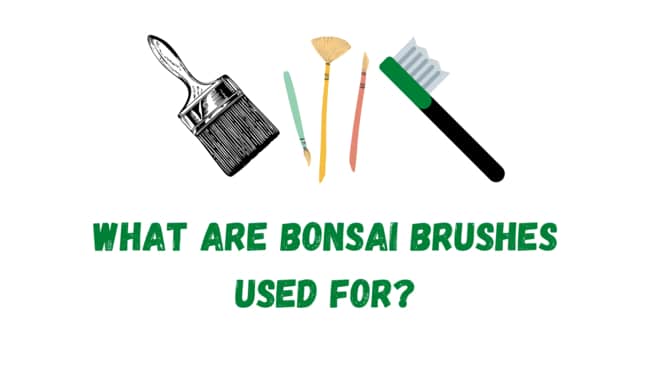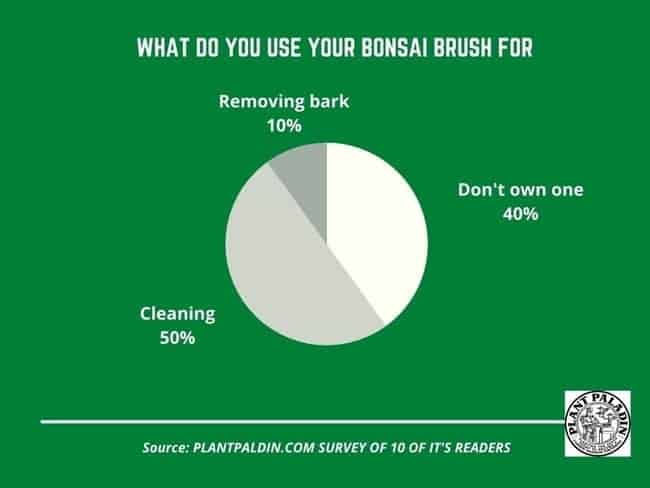This website is supported by its readers. If you click one of my links I may earn a commission. I am also a participant in the Amazon affiliates program and I will also earn a commission from qualified purchases.

Whilst on my journey of growing bonsai trees, one of the biggest surprises I’ve come across is the number of different tools and accessories required to maintain and grow bonsai trees. One accessory that I’ve been becoming more and more familiar with as of late is bonsai brushes. So what are bonsai brushes used for?
Bonsai brushes are used to clean the bark, branches, and topsoil of your bonsai trees. Metal brushes can also be used to strip the bark off your tree. Bonsai brushes are most commonly used to clean up the tree after carving activities such as branch splitting or trunk bending.
They can also be used to remove any unwanted soil from the outside of your bonsai pot.
So what exactly are bonsai brushes made from. What tree species benefit from using bonsai brushes? And how exactly do you use a bonsai brush? Keep reading to find out more.
Just a quick heads up, over the past three years of running Plantpaladin, hundreds of people have asked for product recommendations. As such, You can find my favorite indoor bonsai tree here (link takes you to Bonsaiboy), my favorite outdoor bonsai tree (link takes you to Bonsaiboy), or have a look at all the products I recommend here.
What are bonsai brushes used for?
So it took me a few months of figuring out what bonsai brushes were exactly used for.
As such, I got in touch with a few bonsai experts, visited Birmingham Botanical Gardens, and undertook a quick survey of plant paladin readers to confirm my suspicions.
To summarize:
- Bonsai brushes are most commonly used to clean bonsai trees.
- This is mainly undertaken after some types of bonsai training have occurred.
- For example, creating Jin, sabamiki, trunk splitting, or general carving can leave bark, cambium, and other debris in and around your bonsai pot.
- Failing to clean this will make for much less visually appealing trees, and in worst-case scenarios, attract common bonsai pests such as aphids, spider mites, scale, slugs, and caterpillars.
- Bonsai brushes are also used to clean up excess topsoil or water residue that might have tipped over onto the surface, leaving you with a clean surface to keep your tree on.
- Finally, they are also most commonly used for creating clean-looking branches and leaves.
- Bonsai trees, especially if they have needle-like leaves such as scots pines, or Junipers or are kept indoors such as Ficus or Jade trees can collect a lot of dirt, dust, and grime in hard to reach areas.
- Using a brush will help keep your tree clean which will be vital if you want your tree to compete in professional bonsai keeping.
- Metal brushes that are made of brass, copper, or iron can also be used to strip the bark from a tree to help create Jin and other deadwood techniques.
How to use a bonsai brush
To use a bonsai brush, simply grip the handle of the brush and in a back and forth motion, move the debris you are cleaning away from your bonsai tree.
Aim to do this 5 to 10 times, check to see if your debris is still there.
If so repeat.
More force will need to be applied on smaller toothbrush like bonsai brushes than larger, broom-like brushes.
If you are using a bonsai brush to clean the topsoil, moss, roots and your pot, aim to use a wider brush that is more broom-like.
This gives a wider surface area and is perfect for removing debris from a wide area.
If you are focusing more on using a bonsai brush to remove stubborn dirt from the leaves, branches, and trunk of your tree, aim to use the more toothbrush-looking bonsai brushes.
What are the different types of bonsai brushes?
Bonsai brushes typically fall into two main categories.
Wider brushes that are more broom-like
These brushes are ideal for cleaning and removing dirt from wider areas of the topsoil, roots, pot, moss, and surfaces you keep your bonsai tree on.
These brushes are also ideal for cleaning up cold frames or greenhouses where you house your bonsai collection.
My recommendation for this type of brush has to be the Kakuri bonsai broom which you can buy here – (Link takes you to Amazon)
It’s lightweight and unlike other broom-like brushes can easily get into smaller narrow areas making for a fantastic cleaning tool.

Thinner toothbrush like brushes
Smaller brushes are used more as precision tools. These often have a long handle with a thinner long brush on the end of them resembling an elongated toothbrush.
These are ideal to be used as precision tools or for delicate areas and so can be used to clean the branches, leaves, and trunk of your tree.
Dirt and grime can get in the crack and tiny crevices in your trees.
If you were to use a wide brush in these areas, it would not be efficient in removing the dirt from these areas.
Thinner brushes also tend to have metal bristles which are ideal for stripping the bark and cambium from a brach for a deadwood technique.
My recommendation for this type of brush has to be the Wazakura bonsai brush which you can buy here – (link takes you to Amazon)
Its bent handle makes it perfect for hard-to-reach areas and its nylon bristles mean this brush will last you years.

How often should I brush my bonsai tree?
Bonsai owners should use a brush to clean their bonsai trees once every two weeks. This will prevent an excess build-up of dirt and dust from accumulating on your tree.
Attention should also be paid after watering repotting or carving your tree which may require extra brushing sessions due to mess caused by these activities.
What tree species benefit from using bonsai brushes?
Bonsai tree species that have a needle or pine-like leaves such as juniper, scots pine, and other pine varieties will benefit the most from bonsai brushes. Their branches and trunks are more gnarly leaving more room for dirt and dust to be trapped in these areas.
Other tree species that are either kept indoors or have large leaves will also benefit from regular brushing.
Does brushing damage a bonsai tree?
There are some instances when brushing can damage your bonsai tree.
First, if the material your brush is made up of is too strong for your tree, it can potentially rip off the bark of your tree or uproot your leaves.
As such, avoid using tougher brushes with metal bristles or more delicate trees.
Excessive brushing may also damage your tree, so avoid brushing your bonsai tree more than 3 to 4 times a day if possible.
Especially, if you have a smaller-sized bonsai such as a fingertip-sized tree that can be particularly gentle to maintain.
What are bonsai brushes made from
Bonsai brushes are typically made of Nylon, Coconut brass iron copper, and steel. Nylon and coconut are typically used for cleaning smaller weaker trees. Metal brushes are typically used to clean tougher trees and also help strip the bark from bonsai.
Are bonsai brushes necessary?
Purpose build bonsai brushes are not necessary when it comes to creating bonsai trees. Bonsai brushes can be easily substituted with a toothbrush for provisions brushes and with a moist towel for tougher metal brushes.
How much do bonsai brushes cost?
Purpose build bonsai brushes typically cost between $5 and $25. Brushes with Nylon bristles tend to be cheaper at under $10 with more expensive, coco bristles costing near $30. Metal brushes also cost more than artificial brushes.
Do you use a bonsai brush?
Finally, I wanted to summarize and asked 10 plant paladin readers for what they use their bonsai brushes for.
Here were the result:

My top picks for the gear you will need!
So like I mentioned earlier, over the past three years of running PlantPaladin, hundreds of people have asked me for my recommendations on the best bonsai gear on the market.
Having spent thousands of dollars on bonsai items these past few years and tested at least 100 bonsai-specific products, I’ve listed my favorite products below – All of which I highly recommend and think you can get great value.
They can purchase directly by clicking the link to take them to Amazon.
Bonsai Tool Set: One of the significant challenges I’ve had is finding a toolset that was not only durable but didn’t break the bank. SOLIGT has recently developed a fantastic bonsai tool set that covers all the tools you need to trim, prune, and repot your trees. – You can grab it here.
Complete Bonsai Set: Many of you will want to grow your bonsai trees entirely from scratch, but finding the varicose seeds, pots, and other items in one place can be challenging. Leaves and Sole then have created a complete bonsai set that I’ve personally used that ticks all the boxes. You can grab it here.
Bonsai wire: The number of times I’ve run out of wire for my bonsai or purchased cheap bonsai wire that doesn’t do the job is embarrassing for me to admit. After a lot of trial and error, I found that using Hotop’s aluminum bonsai wire is one of the best options on the market. This can easily be used for both indoor and outdoor bonsai. You can grab it here.
This post was written by Fehed Nicass who has been passionate about bonsai for over 3 years.


